Wayfinding in Virtual Reality Serious Game: An Exploratory Study in the Context of User Perceived Experiences
Abstract
:1. Introduction
2. Related Work
2.1. Virtual Reality Serious Games for Natural Disasters
2.2. Wayfinding in Virtual Reality Training Simulations
2.3. Materials
2.3.1. Participants
2.3.2. Equipment
2.3.3. Virtual Reality Environment
2.4. Evaluation Measures
2.4.1. Physiological Evaluation
2.4.2. Psychometric Evaluation
2.5. Procedure
- Task 1: There are four doors in the parking lot. Find the Fire Exit Door. The door will open once you get closer and press the trigger button. You will find yourself in the city streets once you exit the door.
- Task 2: Find the safe zone (water tank building) and climb up to save yourself. Make sure to climb up on the tank. You will find instructions on how to quit the game once you reach the top.
3. Results
3.1. Physiological Evaluation
3.2. Psychometric Evaluation
4. Discussion
4.1. Effects of Wayfinding on Physiological Evaluation
4.2. Effect of Wayfinding on Psychometric Evaluation
5. Conclusions
Author Contributions
Funding
Institutional Review Board Statement
Informed Consent Statement
Data Availability Statement
Conflicts of Interest
Abbreviations
| XR | Extended reality |
| VR | Virtual Reality |
| SGs | Serious games |
| HMD | Head mounted Display |
| VRE | Virtual Reality Environments |
| CRED | Center for Research on the Epidemiology of Disasters |
| HR | Heart Rate |
| CC | Control Condition |
| EC1 | Experimental Condition 1 |
| EC2 | Experimental Condition 2 |
| HRV | Heart Rate Variability |
| GEQ | Game Experience Questionnaire |
| ACR | Absolute Category Rating |
| SOPS | Standard Operating Procedures |
| ANOVA | Analysis of Variance |
Appendix A. GEQ Questionnaire
| Questions | ||
|---|---|---|
| Q2 | I felt skilful | |
| Q10 | I felt competent | |
| Competence | Q15 | I was good at it |
| Q17 | I felt successful | |
| Q21 | I was fast at reaching the game’s targets | |
| Q3 | I was interested in the game’s story | |
| Immersion | Q12 | It was aesthetically pleasing |
| Q18 | I felt imaginative | |
| Q19 | I felt that I could explore things | |
| Q27 | I found it impressive | |
| Q30 | It felt like a rich experience | |
| Q5 | I was fully occupied with the game | |
| Q13 | I forgot everything around me | |
| Flow | Q25 | I lost track of time |
| Q28 | I was deeply concentrated in the game | |
| Q31 | I lost connection with the outside world | |
| Q22 | I felt annoyed | |
| Tension | Q24 | I felt irritable |
| Q29 | I felt frustrated | |
| Q11 | I thought it was hard | |
| Challenge | Q23 | I felt pressured |
| Q26 | I felt challenged | |
| Q32 | I felt time pressure | |
| Q33 | I had to put a lot of effort into it | |
| Q1 | I felt content | |
| Q4 | I thought it was fun | |
| Positive Affects | Q6 | I felt happy |
| Q14 | I felt good | |
| Q20 | I enjoyed it | |
| Q7 | It gave me a bad mood | |
| Negative Affects | Q8 | I thought about other things |
| Q9 | I found it tiresome | |
| Q16 | I felt bored | |
References
- Doolani, S.; Wessels, C.; Kanal, V.; Sevastopoulos, C.; Jaiswal, A.; Nambiappan, H.; Makedon, F. A review of extended reality (xr) technologies for manufacturing training. Technologies 2020, 8, 77. [Google Scholar] [CrossRef]
- Guilbaud, P.; Guilbaud, T.C.; Jennings, D. Extended Reality, Pedagogy, and Career Readiness: A Review of Literature. In International Conference on Human-Computer Interaction; Springer: Berlin/Heidelberg, Germany, 2021; pp. 595–613. [Google Scholar]
- Muñoz-Saavedra, L.; Miró-Amarante, L.; Domínguez-Morales, M. Augmented and virtual reality evolution and future tendency. Appl. Sci. 2020, 10, 322. [Google Scholar] [CrossRef] [Green Version]
- Beck, D. Augmented and Virtual Reality in Education: Immersive Learning Research. J. Educ. Comput. Res. 2019, 57, 1619–1625. [Google Scholar] [CrossRef]
- Ammanuel, S.; Brown, I.; Uribe, J.; Rehani, B. Creating 3D models from radiologic images for virtual reality medical education modules. J. Med. Syst. 2019, 43, 166. [Google Scholar] [CrossRef]
- Papadopoulou, P.; Chui, K.T.; Daniela, L.; Lytras, M.D. Virtual and Augmented Reality in Medical Education and Training: Innovative Ways for Transforming Medical Education in the 21st Century. In Cognitive Computing in Technology-Enhanced Learning; IGI Global: Hershey, PA, USA, 2019; pp. 109–150. [Google Scholar]
- Kaplan, A.D.; Cruit, J.; Endsley, M.; Beers, S.M.; Sawyer, B.D.; Hancock, P. The Effects of Virtual Reality, Augmented Reality, and Mixed Reality as Training Enhancement Methods: A Meta-Analysis. Hum. Factors 2020, 63, 706–726. [Google Scholar] [CrossRef] [PubMed]
- Checa, D.; Bustillo, A. A review of immersive virtual reality serious games to enhance learning and training. Multimed. Tools Appl. 2020, 79, 5501–5527. [Google Scholar] [CrossRef] [Green Version]
- Harvey, C.; Selmanović, E.; O’Connor, J.; Chahin, M. A comparison between expert and beginner learning for motor skill development in a virtual reality serious game. Vis. Comput. 2019, 37, 3–17. [Google Scholar] [CrossRef] [Green Version]
- Lovreglio, R.; Gonzalez, V.; Amor, R.; Spearpoint, M.; Thomas, J.; Trotter, M.; Sacks, R. The need for enhancing earthquake evacuee safety by using virtual reality serious games. In Proceedings of the ACM SIGGRAPH 2019 Lean & Computing in Construction Congress, Heraklion, Greece, 4–12 July 2017. [Google Scholar]
- Lin, J.; Zhu, R.; Li, N.; Becerik-Gerber, B. How occupants respond to building emergencies: A systematic review of behavioral characteristics and behavioral theories. Saf. Sci. 2020, 122, 104540. [Google Scholar] [CrossRef]
- Ferguson, C.; van den Broek, E.L.; van Oostendorp, H. On the role of interaction mode and story structure in virtual reality serious games. Comput. Educ. 2020, 143, 103671. [Google Scholar] [CrossRef]
- Vasey, K.; Bos, O.; Nasser, F.; Tan, A.; Li, J.T.B.; Tat, K.E.; Marsh, T. Water Bodies: VR Interactive Narrative and Gameplay for Social Impact. In Proceedings of the 17th International Conference on Virtual-Reality Continuum and Its Applications in Industry, Brisbane, Australia, 14–16 November 2019; pp. 1–2. [Google Scholar]
- Feng, Z.; González, V.A.; Mutch, C.; Amor, R.; Rahouti, A.; Baghouz, A.; Li, N.; Cabrera-Guerrero, G. Towards a customizable immersive virtual reality serious game for earthquake emergency training. Adv. Eng. Inform. 2020, 46, 101134. [Google Scholar] [CrossRef]
- For Research on the Epidemiology of Disasters UN Office for Disaster Risk Reduction. In Human Cost of Disaster: An Overview of Last 20 Years; Technical Report; UN Office for Disaster Risk Reduction: Geneva, Switzerland, 2020.
- Leder, J.; Horlitz, T.; Puschmann, P.; Wittstock, V.; Schütz, A. Comparing immersive virtual reality and powerpoint as methods for delivering safety training: Impacts on risk perception, learning, and decision making. Saf. Sci. 2019, 111, 271–286. [Google Scholar] [CrossRef]
- Caballero, A.R.; Niguidula, J.D. Disaster Risk Management and Emergency Preparedness: A Case-Driven Training Simulation Using Immersive Virtual Reality. In Proceedings of the 4th International Conference on Human-Computer Interaction and User Experience in Indonesia, CHIuXiD’18, Yogyakarta, Indonesia, 23–29 March 2018; pp. 31–37. [Google Scholar]
- Susi, T.; Johannesson, M.; Backlund, P. Serious Games: An Overview. 2007. Available online: https://www.ixueshu.com/document/616a880bc1715ca7318947a18e7f9386.html (accessed on 19 June 2021).
- Sermet, Y.; Demir, I. Flood action VR: A virtual reality framework for disaster awareness and emergency response training. In ACM SIGGRAPH; ACM: Los Angeles, CA, USA, 2019; pp. 1–2. [Google Scholar]
- Grassini, S.; Laumann, K.; Rasmussen Skogstad, M. The use of virtual reality alone does not promote training performance (but sense of presence does). Front. Psychol. 2020, 11, 1743. [Google Scholar] [CrossRef] [PubMed]
- Breuer, R.; Sewilam, H.; Nacken, H.; Pyka, C. Exploring the application of a flood risk management Serious Game platform. Environ. Earth Sci. 2017, 76, 93. [Google Scholar] [CrossRef]
- Zaalberg, R.; Midden, C.J. Living behind dikes: Mimicking flooding experiences. Risk Anal. 2013, 33, 866–876. [Google Scholar] [CrossRef] [PubMed]
- Stavroulia, K.E.; Christofi, M.; Zarraonandia, T.; Michael-Grigoriou, D.; Lanitis, A. Virtual reality environments (VREs) for training and learning. In Learning in a Digital World; Springer: Berlin/Heidelberg, Germany, 2019; pp. 195–211. [Google Scholar]
- Carpman, J.; Grant, M. Wayfinding: A broad view. In Handbook of Environmental Psychology; Bechtel, R.B., Churchman, A., Eds.; John Wiley & Sons, Inc.: Hoboken, NJ, USA, 2002; pp. 427–442. Available online: https://psycnet.apa.org/record/2002-02395-028 (accessed on 19 June 2021).
- Jerald, J. The VR Book: Human-Centered Design for Virtual Reality; Morgan & Claypool: San Rafael, CA, USA, 2015. [Google Scholar]
- Shi, Y.; Kang, J.; Xia, P.; Tyagi, O.; Mehta, R.K.; Du, J. Spatial knowledge and firefighters’ wayfinding performance: A virtual reality search and rescue experiment. Saf. Sci. 2021, 139, 105231. [Google Scholar] [CrossRef]
- Du, J.; Wang, Q.; Lin, Y.; Ahn, C. Personalize wayfinding information for fire responders based on virtual reality training data. In Proceedings of the 52nd Hawaii International Conference on System Sciences, Maui, HI, USA, 8–11 January 2019. [Google Scholar]
- Vilar, E.; Rebelo, F. Virtual reality in wayfinding studies. In Proceedings of the 2nd International Conference on Applied Human Factors and Ergonomics Jointly with 12th International Conference on Human Aspects of Advanced Manufacturing (HAAMAHA), Las Vegas, NY, USA, 14–17 July 2008; pp. 14–17. [Google Scholar]
- Dondlinger, M.J.; Lunce, L.M. Wayfinding affordances are essential for effective use of virtual environments for instructional applications. MERLOT J. Online Learn. Teach. 2009, 5, 562–569. [Google Scholar]
- Sharma, G.; Kaushal, Y.; Chandra, S.; Singh, V.; Mittal, A.P.; Dutt, V. Influence of landmarks on wayfinding and brain connectivity in immersive virtual reality environment. Front. Psychol. 2017, 8, 1220. [Google Scholar] [CrossRef] [Green Version]
- Fujimi, T.; Fujimura, K. Testing public interventions for flash flood evacuation through environmental and social cues: The merit of virtual reality experiments. Int. J. Disaster Risk Reduct. 2020, 50, 101690. [Google Scholar] [CrossRef]
- Kostakos, P.; Alavesa, P.; Korkiakoski, M.; Marques, M.M.; Lobo, V.; Duarte, F. Wired to Exit: Exploring the Effects of Wayfinding Affordances in Underground Facilities Using Virtual Reality. Simul. Gaming 2021, 52, 107–131. [Google Scholar] [CrossRef]
- Liang, Z.; Zhou, K.; Gao, K. Development of virtual reality serious game for underground rock-related hazards safety training. IEEE Access 2019, 7, 118639–118649. [Google Scholar] [CrossRef]
- Lin, J.; Cao, L.; Li, N. Assessing the influence of repeated exposures and mental stress on human wayfinding performance in indoor environments using virtual reality technology. Adv. Eng. Inform. 2019, 39, 53–61. [Google Scholar] [CrossRef]
- Zhu, R.; Lin, J.; Becerik-Gerber, B.; Li, N. Influence of architectural visual access on emergency wayfinding: A cross-cultural study in China, United Kingdom and United States. Fire Saf. J. 2020, 113, 102963. [Google Scholar] [CrossRef]
- Wu, A.; Zhang, W.; Zhang, X. Evaluation of wayfinding aids in virtual environment. Int. J. Hum. Comput. Interact. 2009, 25, 1–21. [Google Scholar] [CrossRef]
- International Telecommunication Union. Influencing Factors on Quality of Experience for Virtual Reality Services; Standard; International Telecommunication Union: Geneva, Switzerland, 2020. [Google Scholar]
- Jost, T.A.; Nelson, B.; Rylander, J. Quantitative analysis of the Oculus Rift S in controlled movement. Disabil. Rehabil. Assist. Technol. 2019, 1–5. [Google Scholar] [CrossRef] [PubMed]
- Passos, D.E.; Jung, B. Measuring the accuracy of inside-out tracking in XR devices using a high-precision robotic arm. In International Conference on Human-Computer Interaction; Springer: Berlin/Heidelberg, Germany, 2020; pp. 19–26. [Google Scholar]
- Chessa, M.; Maiello, G.; Borsari, A.; Bex, P.J. The perceptual quality of the oculus rift for immersive virtual reality. Hum. Comput. Interact. 2019, 34, 51–82. [Google Scholar] [CrossRef]
- Oculus Oculus Native Spatializer Plugin (ONSP). 2020. Available online: https://developer.oculus.com/downloads/package/oculus-spatializer-unity/ (accessed on 19 June 2021).
- Boletsis, C.; Cedergren, J.E. VR locomotion in the new era of virtual reality: An empirical comparison of prevalent techniques. Adv. Hum. Comput. Interact. 2019, 2019. [Google Scholar] [CrossRef]
- Keil, J.; Edler, D.; O’Meara, D.; Korte, A.; Dickmann, F. Effects of virtual reality locomotion techniques on distance estimations. ISPRS Int. J. Geo-Inf. 2021, 10, 150. [Google Scholar] [CrossRef]
- Vilar, E.; Rebelo, F.; Noriega, P. Smart systems in emergency wayfinding: A literature review. In International Conference of Design, User Experience, and Usability; Springer: Berlin/Heidelberg, Germany, 2018; pp. 379–388. [Google Scholar]
- Cosma, G.; Ronchi, E.; Nilsson, D. Way-finding lighting systems for rail tunnel evacuation: A virtual reality experiment with Oculus Rift®. J. Transp. Saf. Secur. 2016, 8, 101–117. [Google Scholar] [CrossRef]
- Wang, C.; Lizardo, O.; Hachen, D.S. Using Fitbit data to examine factors that affect daily activity levels of college students. PLoS ONE 2021, 16, e0244747. [Google Scholar]
- Strik, M.; Ploux, S.; Ramirez, F.D.; Abu-Alrub, S.; Jais, P.; Haïssaguerre, M.; Bordachar, P. Smartwatch-based detection of cardiac arrhythmias Beyond the differentiation between sinus rhythm and atrial fibrillation. Heart Rhythm 2021. [Google Scholar] [CrossRef]
- Kumar, A.; Komaragiri, R.; Kumar, M. A Review on Computation Methods Used in Photoplethysmography Signal Analysis for Heart Rate Estimation. Arch. Comput. Methods Eng. 2021, 1–20. [Google Scholar] [CrossRef]
- IJsselsteijn, W.A.; de Kort, Y.A.; Poels, K. The game experience questionnaire. Eindh. Tech. Univ. Eindh. 2013, 46, 257–270. [Google Scholar]
- IJsselsteijn, W.; De Kort, Y.; Poels, K.; Jurgelionis, A.; Bellotti, F. Characterising and measuring user experiences in digital games. In Proceedings of the International Conference on Advances in Computer Entertainment Technology, Salzburg, Austria, 13–15 June 2007; Volume 2, p. 27. [Google Scholar]
- Christensen, J.V.; Mathiesen, M.; Poulsen, J.H.; Ustrup, E.E.; Kraus, M. Player experience in a VR and non-VR multiplayer game. In Proceedings of the Virtual Reality International Conference-Laval Virtual, Laval, France, 4–6 April 2018; pp. 1–4. [Google Scholar]
- International Telecommunication Union. Subjective Video Quality Assessment Methods for Multimedia Applications; Standard; International Telecommunication Union: Geneva, Switzerland, 2008. [Google Scholar]
- IJsselsteijn, W.; Van Den Hoogen, W.; Klimmt, C.; De Kort, Y.; Lindley, C.; Mathiak, K.; Poels, K.; Ravaja, N.; Turpeinen, M.; Vorderer, P. Measuring the experience of digital game enjoyment. In Proceedings of the Measuring Behavior, Noldus Information Tecnology, Wageningen, The Netherlands, 26–29 August 2008; Volume 2008, pp. 88–89. [Google Scholar]
- Verghote, A.; Al-Haddad, S.; Goodrum, P.; Van Emelen, S. The effects of information format and spatial cognition on individual wayfinding performance. Buildings 2019, 9, 29. [Google Scholar] [CrossRef] [Green Version]
- Denisova, A.; Guckelsberger, C.; Zendle, D. Challenge in digital games: Towards developing a measurement tool. In Proceedings of the 2017 Chi Conference Extended Abstracts on Human Factors in Computing Systems, Denver, CO, USA, 6–11 May 2017; pp. 2511–2519. [Google Scholar]
- Cole, T.; Gillies, M. Thinking and doing: Challenge, agency, and the eudaimonic experience in video games. Games Cult. 2021, 16, 187–207. [Google Scholar] [CrossRef]
- Pallavicini, F.; Pepe, A. Comparing player experience in video games played in virtual reality or on desktop displays: Immersion, flow, and positive emotions. In Proceedings of the Extended Abstracts of the Annual Symposium on Computer-Human Interaction in Play Companion Extended Abstracts, Barcelona, Spain, 22–25 October 2019; pp. 195–210. [Google Scholar]
- Zhou, Y.; Ji, S.; Xu, T.; Wang, Z. Promoting knowledge construction: A model for using virtual reality interaction to enhance learning. Procedia Comput. Sci. 2018, 130, 239–246. [Google Scholar] [CrossRef]
- Pollard, K.A.; Oiknine, A.H.; Files, B.T.; Sinatra, A.M.; Patton, D.; Ericson, M.; Thomas, J.; Khooshabeh, P. Level of immersion affects spatial learning in virtual environments: Results of a three-condition within-subjects study with long intersession intervals. Virtual Real. 2020, 24, 783–796. [Google Scholar] [CrossRef]
- Balakrishnan, B.; Sundar, S.S. Where am I? How can I get there? Impact of navigability and narrative transportation on spatial presence. Hum. Comput. Interact. 2011, 26, 161–204. [Google Scholar]
- Lackey, S.; Salcedo, J.; Szalma, J.; Hancock, P. The stress and workload of virtual reality training: The effects of presence, immersion and flow. Ergonomics 2016, 59, 1060–1072. [Google Scholar] [CrossRef]
- Cao, L.; Lin, J.; Li, N. A virtual reality based study of indoor fire evacuation after active or passive spatial exploration. Comput. Hum. Behav. 2019, 90, 37–45. [Google Scholar] [CrossRef]
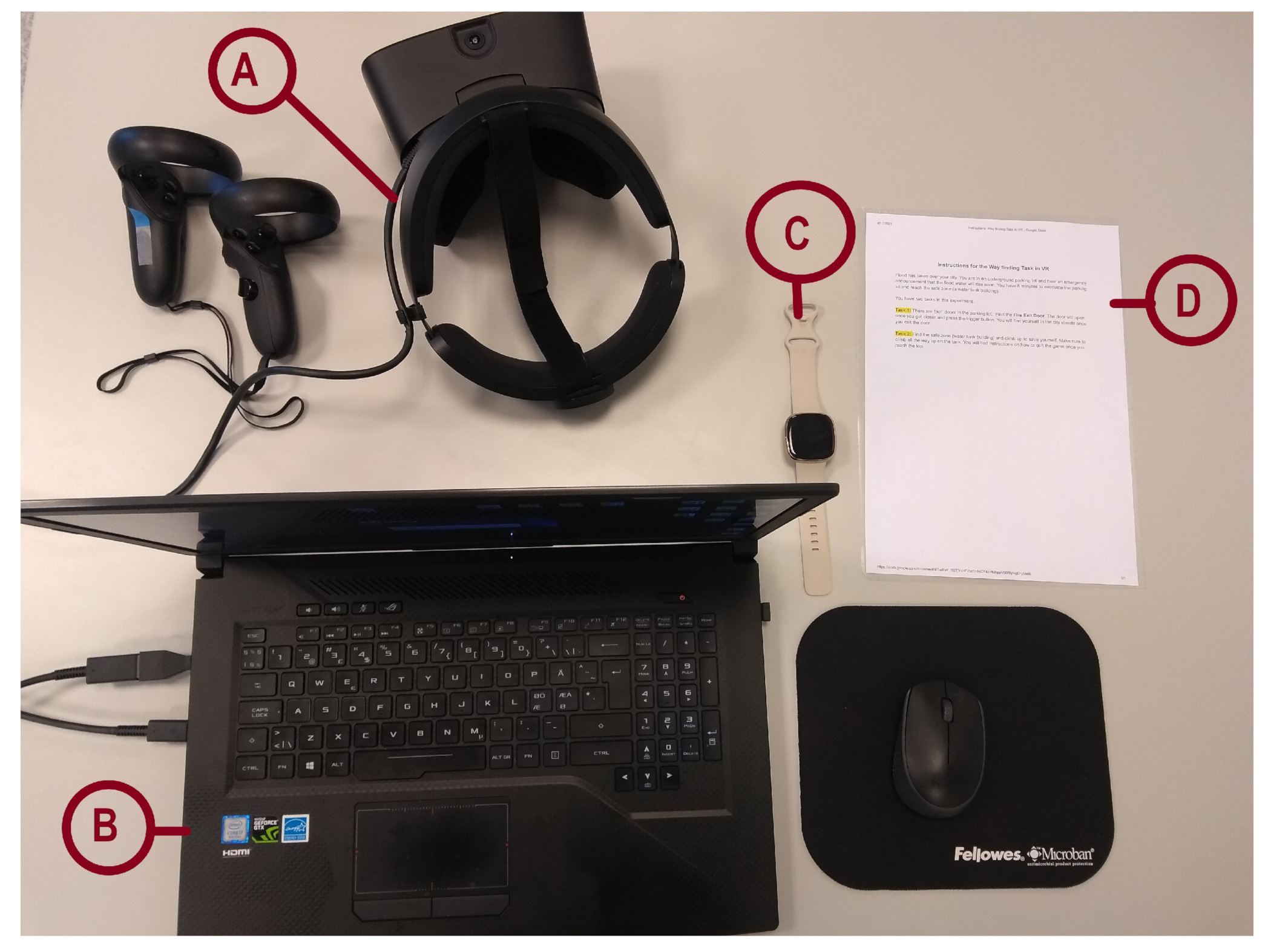
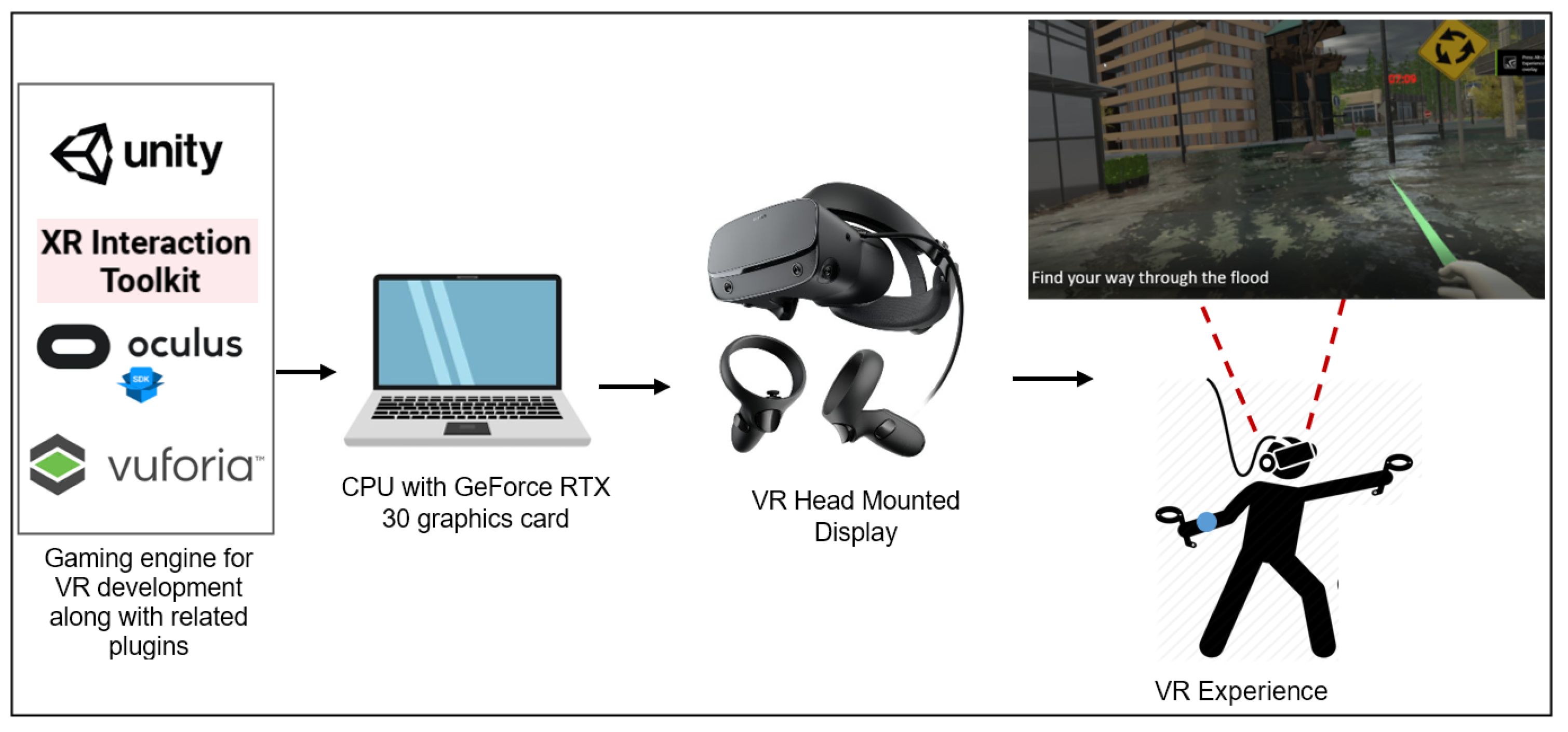
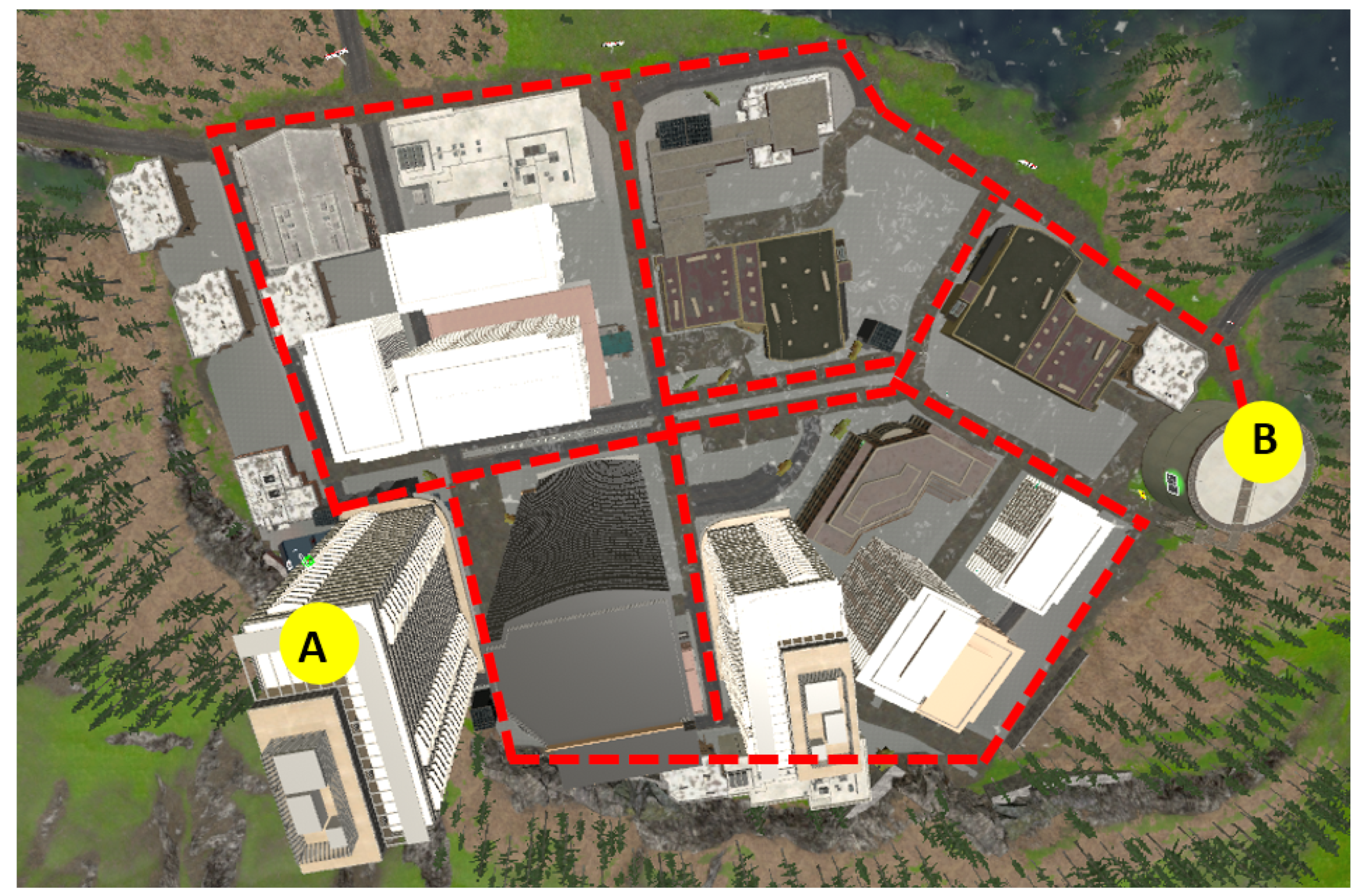
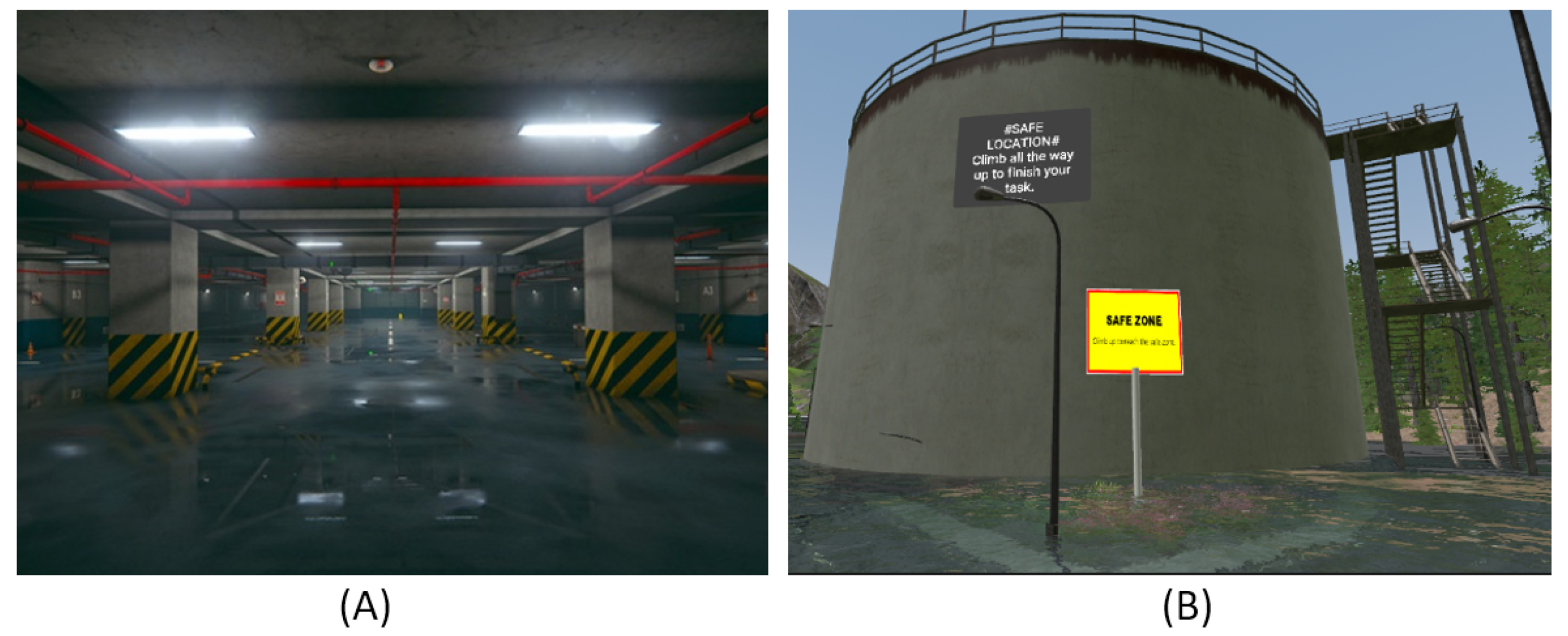
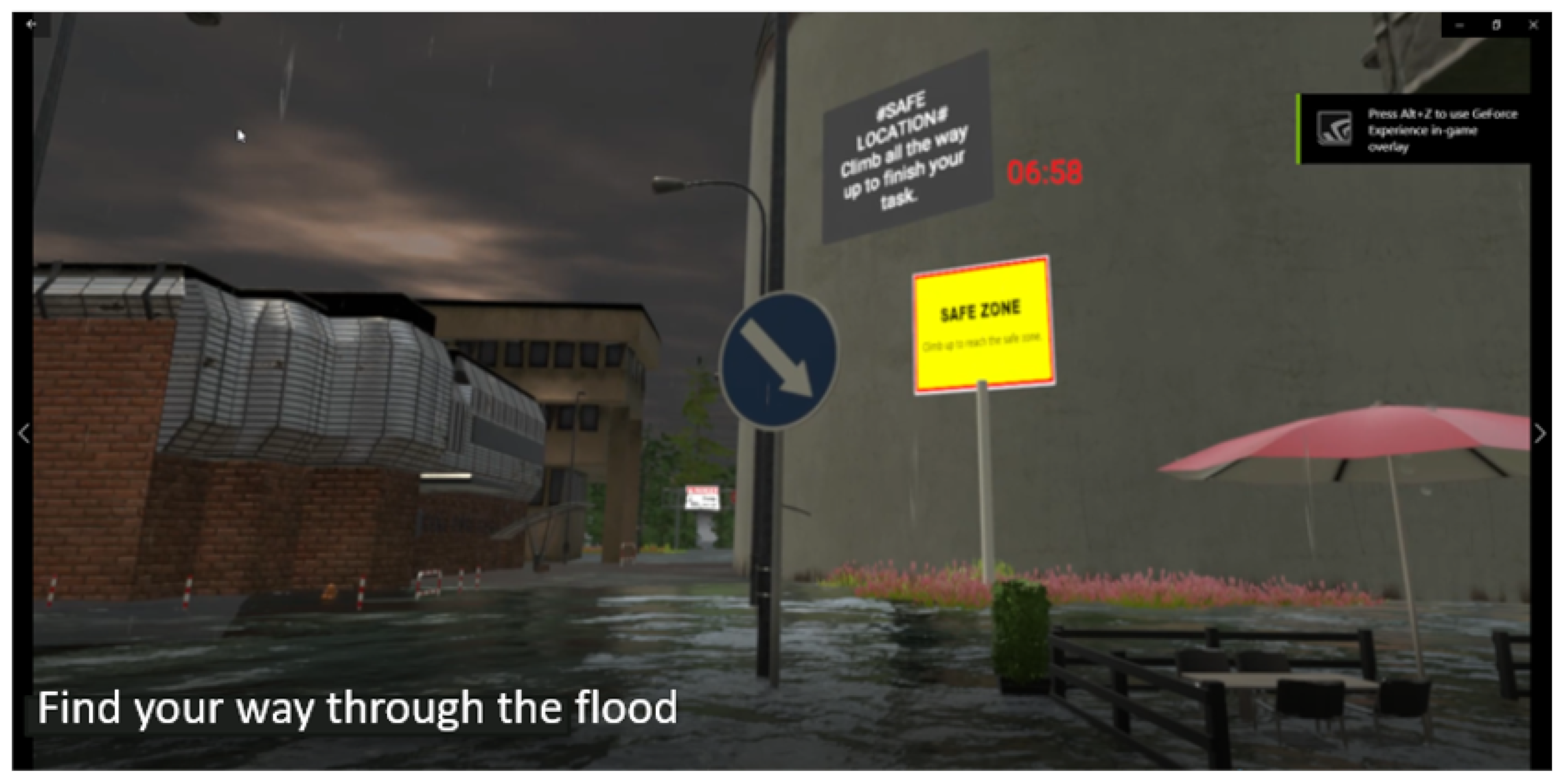
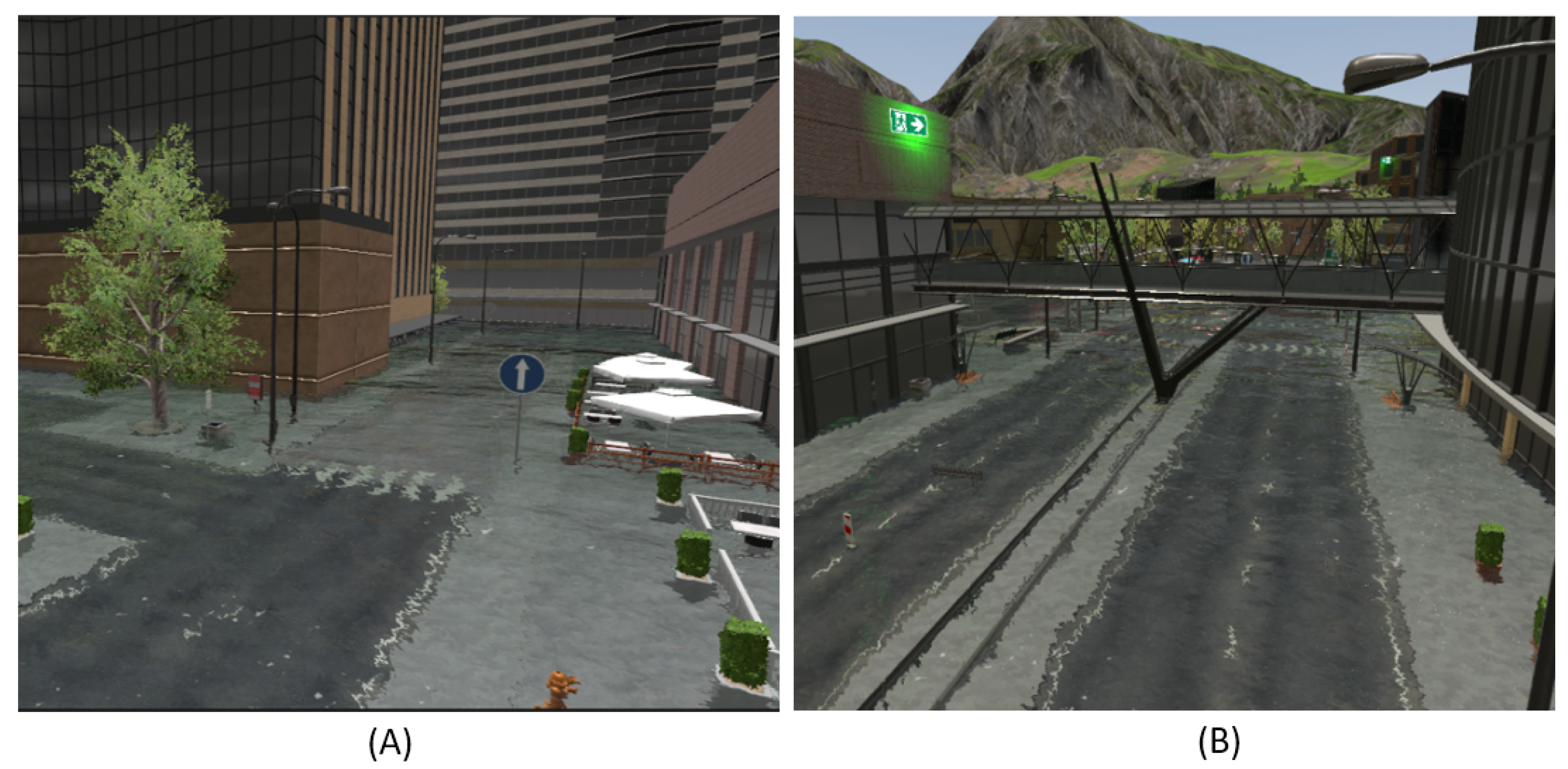

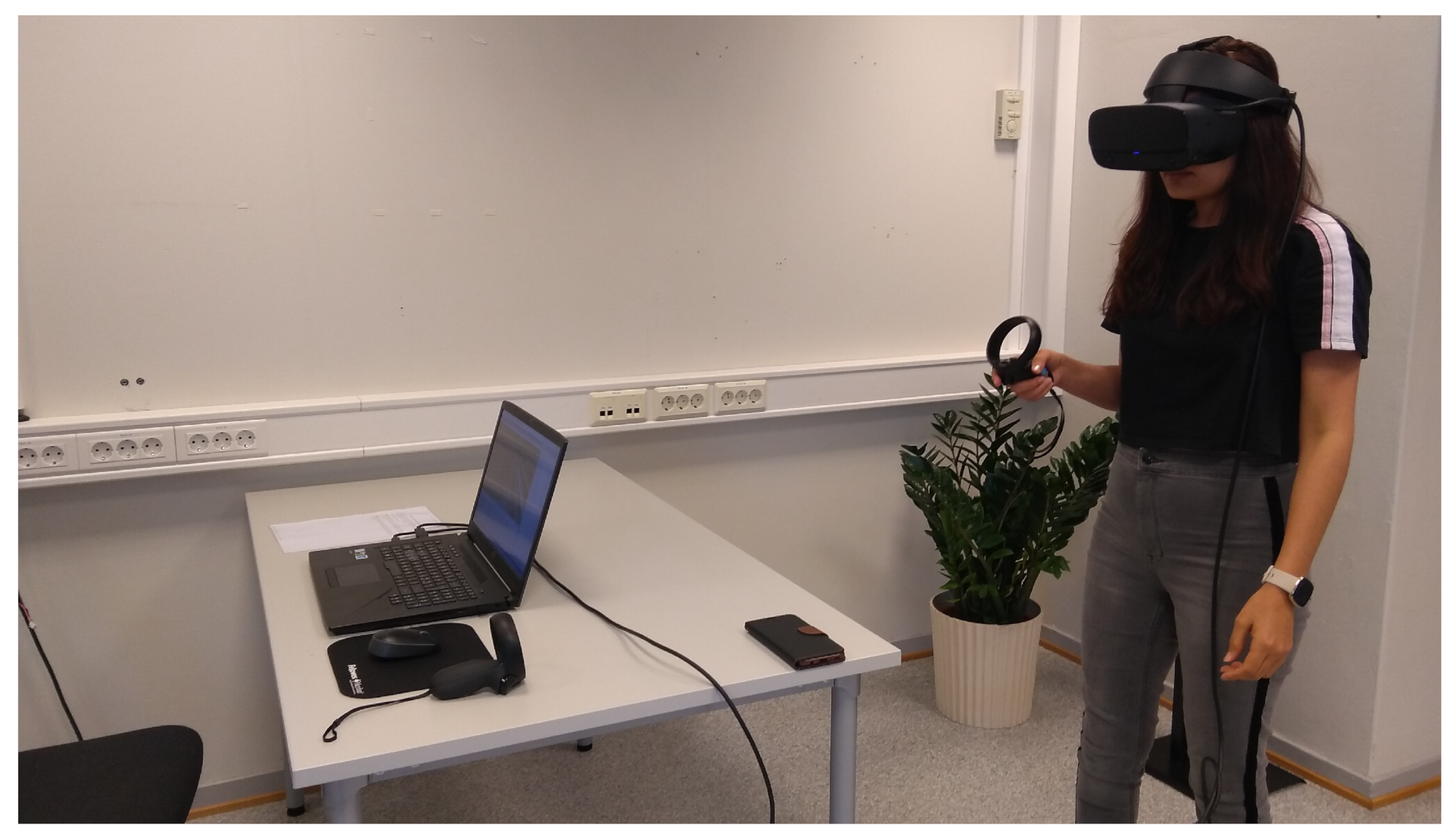
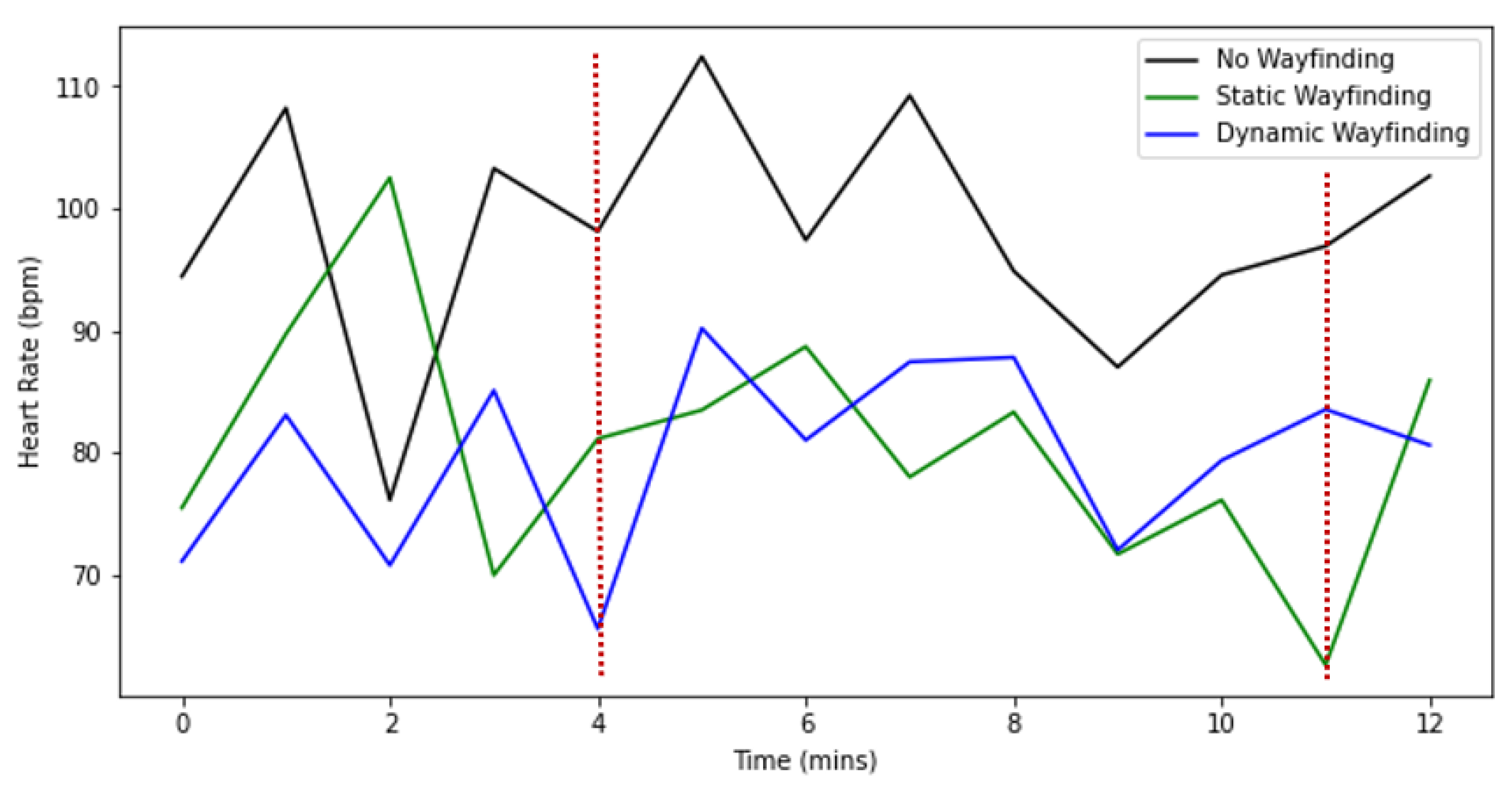
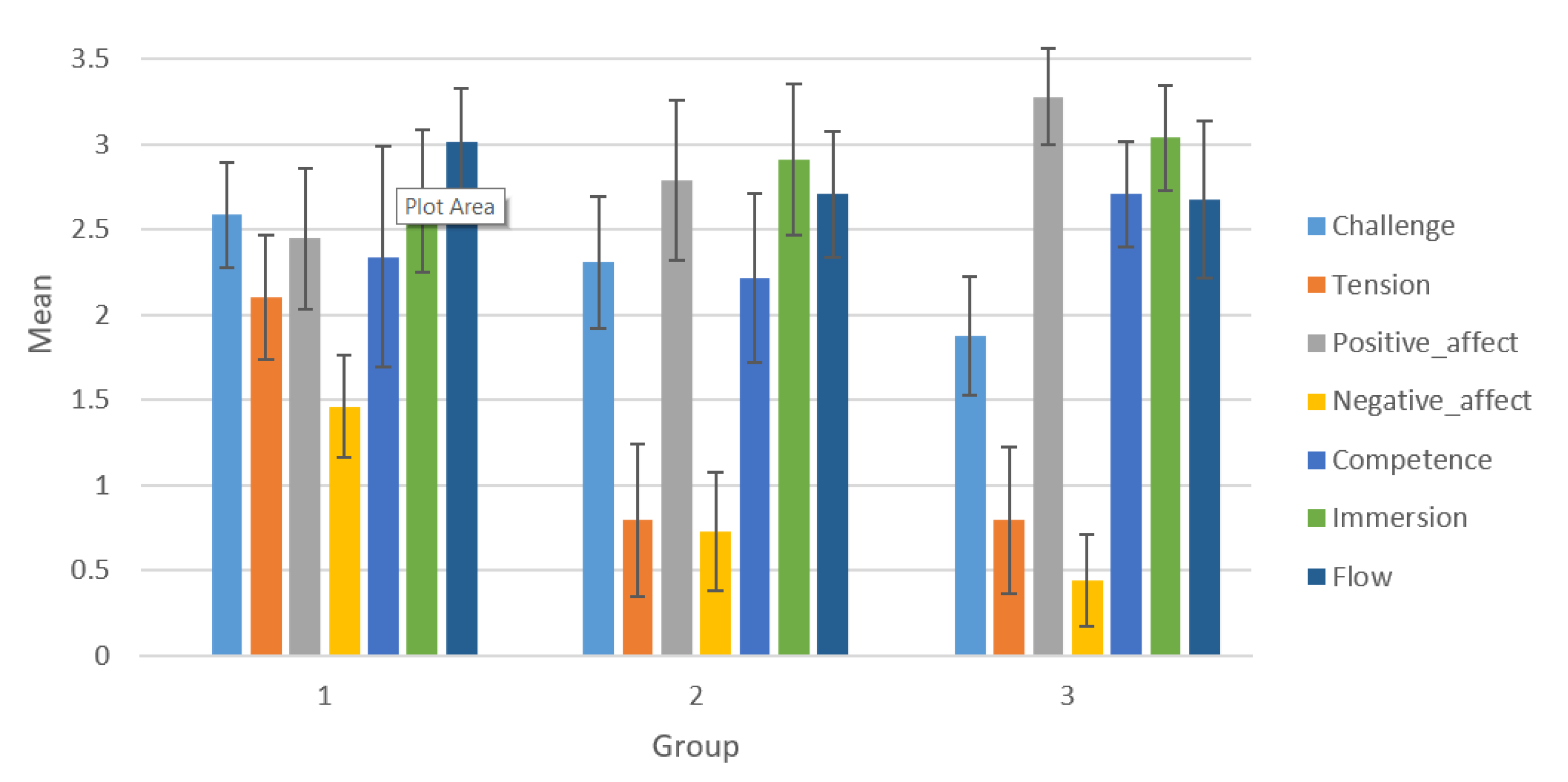
| No | Condition | Variations |
|---|---|---|
| 1 | Control Condition (CC) | No wayfinding cues |
| 2 | Experimental Condition 1 (EC1) | Static wayfinding cues |
| 3 | Experimental Condition 2 (EC2) | Dynamic wayfinding cues with visual stimulus |
| Absolute Category | Rating Scale | |||
|---|---|---|---|---|
| 1 | 2 | 3 | 4 | 5 |
| not at all | slightly | moderately | fairly | extremely |
| Control Condition (n = 13) | Experimental Condition 1 (n = 13) | Experimental Condition 2 (n = 13) | ||||
|---|---|---|---|---|---|---|
| Means | SD | Means | SD | Means | SD | |
| Heart Rate | 97.69 | 9.60 | 80.53 | 10.134 | 79.83 | 7.57 |
| Sum of Squares | df | Mean Square | F | Sig. | ||
|---|---|---|---|---|---|---|
| Between Groups | 2660.839 | 2 | 1330.419 | 15.818 | 0.000 | |
| Heart Rate | Within Groups | 3027.957 | 36 | 84.110 | ||
| Total | 5688.796 | 38 | ||||
| Control Condition (n = 13) | Experimental Condition 1 (n = 13) | Experimental Condition 2 (n = 13) | ||||
|---|---|---|---|---|---|---|
| Means | SD | Means | SD | Means | SD | |
| Challenge | 2.58 | 0.51 | 2.30 | 0.64 | 1.87 | 0.58 |
| Tension | 2.10 | 0.59 | 0.79 | 0.73 | 0.79 | 0.71 |
| Positive Affect | 2.44 | 0.68 | 2.78 | 0.77 | 3.27 | 0.46 |
| Negative Affect | 1.46 | 0.49 | 0.73 | 057 | 0.44 | 0.44 |
| Competence | 2.33 | 1.06 | 2.21 | 0.82 | 2.70 | 0.50 |
| Immersion | 2.66 | 0.69 | 2.91 | 0.72 | 3.03 | 0.51 |
| Flow | 3.01 | 0.51 | 2.70 | 0.60 | 2.67 | 0.75 |
| Sum of Squares | df | Mean Square | F | Sig. | ||
|---|---|---|---|---|---|---|
| Challenge | Between Groups | 3.307 | 2 | 1.653 | 4.907 | 0.013 |
| Within Groups | 12.129 | 36 | 0.337 | |||
| Total | 15.436 | 38 | ||||
| Tension | Between Groups | 14.821 | 2 | 7.410 | 15.700 | 0.000 |
| Within Groups | 16.991 | 36 | 0.472 | |||
| Total | 31.812 | 38 | ||||
| Positive Affect | Between Groups | 4.537 | 2 | 2.269 | 5.286 | 0.010 |
| Within Groups | 15.452 | 36 | 0.429 | |||
| Total | 19.990 | 38 | ||||
| Negative Affect | Between Groups | 7.176 | 2 | 3.588 | 13.878 | 0.000 |
| Within Groups | 9.308 | 36 | 0.259 | |||
| Total | 16.484 | 38 | ||||
| Competence | Between Groups | 1.707 | 2 | 0.853 | 1.233 | 0.303 |
| Within Groups | 24.917 | 36 | 0.692 | |||
| Total | 26.624 | 38 | ||||
| Immersion | Between Groups | 0.927 | 2 | 0.464 | 1.090 | 0.347 |
| Within Groups | 15.321 | 36 | 0.426 | |||
| Total | 16.248 | 38 | ||||
| Flow | Between Groups | 0.911 | 2 | 0.455 | 1.122 | 0.337 |
| Within Groups | 14.609 | 36 | 0.406 | |||
| Total | 15.520 | 38 | ||||
Publisher’s Note: MDPI stays neutral with regard to jurisdictional claims in published maps and institutional affiliations. |
© 2021 by the authors. Licensee MDPI, Basel, Switzerland. This article is an open access article distributed under the terms and conditions of the Creative Commons Attribution (CC BY) license (https://creativecommons.org/licenses/by/4.0/).
Share and Cite
Irshad, S.; Perkis, A.; Azam, W. Wayfinding in Virtual Reality Serious Game: An Exploratory Study in the Context of User Perceived Experiences. Appl. Sci. 2021, 11, 7822. https://doi.org/10.3390/app11177822
Irshad S, Perkis A, Azam W. Wayfinding in Virtual Reality Serious Game: An Exploratory Study in the Context of User Perceived Experiences. Applied Sciences. 2021; 11(17):7822. https://doi.org/10.3390/app11177822
Chicago/Turabian StyleIrshad, Shafaq, Andrew Perkis, and Waleed Azam. 2021. "Wayfinding in Virtual Reality Serious Game: An Exploratory Study in the Context of User Perceived Experiences" Applied Sciences 11, no. 17: 7822. https://doi.org/10.3390/app11177822
APA StyleIrshad, S., Perkis, A., & Azam, W. (2021). Wayfinding in Virtual Reality Serious Game: An Exploratory Study in the Context of User Perceived Experiences. Applied Sciences, 11(17), 7822. https://doi.org/10.3390/app11177822







